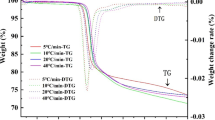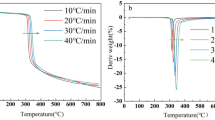Abstract
We have already carried out the research on the pyrolysis kinetics and pyrolysis process mechanism of waste circuit board resin powder. In this study, we focused on the physical and chemical properties of solid–gas–liquid phase products from the pyrolysis of resin powder. The pyrolysis process of WPCB at different heating rates was analyzed by thermogravimetric analyzer (TG), and the parameters were statistically analyzed. Scanning electron microscopy was employed to observe the micro-morphology of the pyrolytic solid products under the high-resolution demonstration conditions of 5 μm and 1 μm, mainly the combination morphology of pyrolytic carbon and glass fiber, and the combination energy spectrum analysis was used to detect the elements C, Si, Al and Ca as the main chemical components of the solid substances. In order to further understand the composition and distribution of functional groups in the pyrolysis residues, the absorption vibration peaks of pyrolysis carbon were determined by Fourier transform infrared spectroscopy (FTIR), and the attribution of different vibration peaks was interpreted. It was found that the key chemical substances were the substitutes of phenol, isopropyl phenol and bisphenol A. The chemical structure types and yield of liquid pyrolysis tar at pyrolysis temperature of 673.15 K were tested by gas chromatography–mass spectrometry (GC–MS). The major constituent of liquid-phase product was phenolic compounds, the total content of which is 74.63%. The composition of non-condensable gasses produced by WPCB under vacuum pyrolysis conditions was observed by GC–MS, mainly containing H2, CO2, CO and CH4. In addition, TG-FTIR was used to further observe the pyrolysis process of WPCB and to track the components of gasses escaping from the pyrolysis process, namely CO2, phenol and substituted phenol. However, TG-FTIR detected bromine in the gas, suggesting that HBr gas may exist. Therefore, when the pyrolysis gas is recycled as fuel gas, it is recommended to first perform the de-bromination treatment of the pyrolysis gas to avoid HBr escape.






Similar content being viewed by others
Abbreviations
- WPCB:
-
Waste printed circuit board
- GC:
-
Gas chromatography
- FTIR:
-
Fourier transform infrared spectroscopy
- GC–MS:
-
Gas chromatography–mass spectrometry
- TGA:
-
Thermogravimetric analysis
- DTG:
-
Derivative thermogravimetry
- SEM:
-
Scanning electron microscopy
References
Kumar A, Holuszko ME, Janke T. Characterization of the nonmetal fraction of the processed waste printed circuit boards. Waste Manag. 2018;75(5):94–102. https://doi.org/10.1016/j.wasman.2018.02.010.
Premur V, AnićVučinić A, Vujević D, et al. The possibility for environmental friendly recycling of printed circuit boards. J Sustain Dev Energy Water Environ Syst. 2016;4(1):14–22. https://doi.org/10.13044/j.sdewes.2016.04.0002.
Li J, Shrivastava P, Zong G, et al. Printed circuit board recycle-ng: a state-of-the-art survey. IEEE T Electron Pack. 2004;27(1):33–42. https://doi.org/10.1109/TEPM.2004.830501.
Richter H, Lorenz W, Bahadir M. Examination of organic and inorganic xenobiotics in equipped printed circuits. Chemosphere. 1997;35(1/2):169–79. https://doi.org/10.1016/S0045-6535(97)00148-3.
Guo XY, Tian QH, Liu Y, et al. Research and application progress of non-ferrous metal resource recycling. T Nonferr Metal Soc. 2019;29(9):1859–901.
Chang X, Wang T, Zhang P, Zhang J, Li A, Gong J. Enhanced surface reaction kinetics and charge separation of p–n heterojunction Co3O4/BiVO4 photo anodes. J Am Chem Soc. 2015;137:8356–9. https://doi.org/10.1021/jacs.5b04186.
Farid MM, Jeong HJ, Hwang J. Co-gasification of coal-biomass blended char with CO2 and H2O: effect of partial pressure of the gasifying agent on reaction kinetics. Fuel. 2015;162:234–8. https://doi.org/10.1016/j.fuel.2015.09.011.
Espenson JH. Chemical kinetics and reaction mechanisms. Citeseer; 1995.
Kim Y-M, Kim S, Lee J-Y, Park Y-K. Pyrolysis reaction pathways of waste epoxy-printed circuit board. Environ Eng Sci. 2013;30:706–12. https://doi.org/10.1089/ees.2013.0166.
Ma C, Yu J, Chen T, Yan Q, Song Z, Wang B, Sun L. Influence of Fe based ZSM-5 catalysts on the vapor intermediates from the pyrolysis of brominated acrylonitrile-butadiene-styrene copolymer (Br-ABS). Fuel. 2018;230:390–6. https://doi.org/10.1016/j.fuel.2018.05.077.
Bhaskar T, Matsui T, Kaneko J, Uddin MA, Muto A, Sakata Y. Novel calcium based sorbent (Ca–C) for the dehalogenation (Br, Cl) process during halogenated mixed plastic (PP/PE/PS/PVC and HIPS-Br) pyrolysis. Green Chem. 2002;4:372–5. https://doi.org/10.1039/B203745A.
Singh S, Wu C, Williams PT. Pyrolysis of waste materials using TGA-MS and TGA-FTIR as complementary characterisation techniques. J Anal Appl Pyrol. 2012;94:99–107. https://doi.org/10.1016/j.jaap.2011.11.011.
Lin KH, Chiang HL. Liquid oil and residual characteristics of printed circuit board recycle by pyrolysis. J Hazard Mater. 2014;271:258–65. https://doi.org/10.1016/j.jhazmat.2014.02.031.
Hall WJ, Williams PT. Separation and recovery of materials from scrap printed circuit boards. Resour Conserv Recy. 2007;51:691–709.
Hall WJ, Williams PT. Processing waste printed circuit boards for material recovery. Circuit World. 2007;4(43–50):4.
Marco ID, Caballero BM, Chomon MJ, et al. Pyrolysis of electrical and electronic wastes. J Anal Appl Pyrol. 2008;82:179–83. https://doi.org/10.1016/j.jaap.2008.03.011.
Moltó J, Egea S, Conesaj A, et al. Thermal decomposition of electronic wastes: mobile phone case and other parts. Waste Manag. 2011;31:2546–52. https://doi.org/10.1016/j.wasman.2011.07.028.
Moltó J, Font R, Galvez A, et al. Pyrolysis and combustion of electronic wastes. J Anal Appl Pyrol. 2009;84:68–78. https://doi.org/10.1016/j.jaap.2008.10.023.
Barontini F, Marsanich K, Petarea L, et al. Thermal degradation and decomposition products of electronic boards containing BFRs. Ind Eng Chem Res. 2005;12:4186–99. https://doi.org/10.1021/ie048766l.
López FA, Martin MI, Alguacil FJ, et al. Thermolysis of fibreglass polyester composite and reutilisation of the glass fibre residue to obtain a glass-ceramic material. J Anal Appl Pyrol. 2012;93:104–12. https://doi.org/10.1016/j.jaap.2011.10.003.
Peng SH, et al. Vacuum pyrolysis of waste circuit boards. J Chem Eng. 2006;11:2720–6.
Sun LS. Pyrolysis mechanism of waste printed circuit boards and experimental research on product recycling. Huazhong University of Science and Technology; 2004.
Guo XJ. Experimental study on the treatment of waste printed circuit boards by pyrolysis technology. Tianjin University; 2008.
Quan C, Li AM, et al. Pyrolysis characteristics and kinetic analysis of waste circuit boards. J Saf Environ. 2008(5).
Jie G, Li YS, Lu MX. Product characterization of waste printed circuit board by pyrolysis. J Anal Appl Pyrol. 2008;83(2):185–9. https://doi.org/10.1016/j.jaap.2008.08.007.
Quan C, Li R, Gao R, et al. Characterization of products recycling from PCB waste pyrolysis. J Anal Appl Pyrol. 2010;89(1):102–6. https://doi.org/10.1016/j.jaap.2010.06.002.
Mohammed IY, Abakr YA, Hui JNX, Alaba PA, Morris KI, Ibrahim MD. Recovery of clean energy precursors from Bambara groundnut waste via pyrolysis:Kinetics, products distribution and optimisation using response surface methodology. J Clean Prod. 2017;164:1430–45. https://doi.org/10.1016/j.jclepro.2017.07.068.
Alaba PA, Popoola SI, Abnisal F, Lee CS, Ohunakin OS, Adetiba E, Akanle MB, Abdul Patah MF, Atayero AAA, Daud WMAW. Thermal decomposition of rice husk: a comprehensive artificial intelligence predictive model. J Therm Anal Calorim. 2020;140:1811–23. https://doi.org/10.1007/s10973-019-08915-0.
Krishna JVJ, Damir SS, Vinu R. Pyrolysis of electro-nic waste and their mixtures: kinetic and pyrolysate composition studies. J Environ Chem Eng. 2021;9(4):105382. https://doi.org/10.1016/j.jece.2021.105382.
Lam SS, Liew RK, Jusoh A, Chong CT, Ani FN, Chase HA. Progress in waste oil to sustainable energy, with emphasis on pyrolysis techniques. Renew Sust Energ Rev. 2016;53:741–53. https://doi.org/10.1016/j.rser.2015.09.005.
Nie CC, Wang YY, Zhang H, Zhang YK, Zhang YQ, Yan ZQ, Li B, Lyu XJ, Tao YJ, Qiu J, Li L, Zhang GW, Zhu XN. Cleaner utilization of non-metallic components in separation tailings of waste printed circuit board: pyrolysis oil, calorific value and building aggregate. J Clean Prod. 2020;258:120976. https://doi.org/10.1016/j.jclepro.2020.120976.
Wu D, Ding G, Chi W, et al. Research on the pyrolysis kinetics of resin powder on waste printed circuit board with different particle sizes at different heating rates: inspiration for the pyrolysis mechanism. J Therm Anal Calorim. 2021;147:8047–59. https://doi.org/10.1007/s10973-021-11102-9.
Zhan ZH. Experiment and mechanism of vacuum thermal cracking of epoxy resin on waste circuit boards. Central South University; 2012.
Yu SL, Li YW. Spectral analysis method. Chongqing: Chongqing University Press; 2003. p. 34–41.
Zhu HM, Jiang XG, Yan JH, et al. TG-FTIR analysis of PVC thermal degradation and HCI removal. J Anal Appl Pyrol. 2008;82(1):1–9. https://doi.org/10.1016/j.jaap.2007.11.011.
Bhaskar T, Kaneko J, Muto A, et al. Pyrolysis studies of PP/PE/PS/PVC/HIPS-Br plastics mixed with PET and dehalogenation (Br, CI) of the liquid products. J Anal Appl Pyrol. 2004;72(1):27–33.
Acknowledgements
We acknowledge supports from the Anhui Province Major Scientific and Technological Research Projects (201903a07020019) and the Anhui Province “115” Innovation Industry Team (13th batch). We would like to express our honest gratitude to Ndhlovu kataza nyasha of Anhui Jianzhu University for the work of revising and polishing the language of this manuscript.
Author information
Authors and Affiliations
Corresponding authors
Additional information
Publisher's Note
Springer Nature remains neutral with regard to jurisdictional claims in published maps and institutional affiliations.
Rights and permissions
Springer Nature or its licensor holds exclusive rights to this article under a publishing agreement with the author(s) or other rightsholder(s); author self-archiving of the accepted manuscript version of this article is solely governed by the terms of such publishing agreement and applicable law.
About this article
Cite this article
Wu, D., Cai, G., Chi, W. et al. Micro-characteristics of solid–gas–liquid phase pyrolysis products of waste printed circuit board resin powder driven by multi-type spectral data. J Therm Anal Calorim 147, 13925–13934 (2022). https://doi.org/10.1007/s10973-022-11607-x
Received:
Accepted:
Published:
Issue Date:
DOI: https://doi.org/10.1007/s10973-022-11607-x




